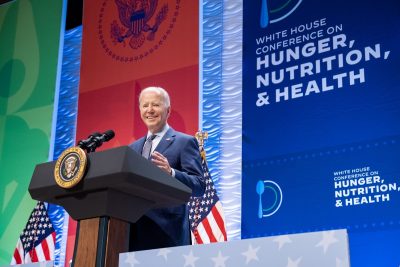
President Joe Biden last week introduced a plan to end hunger in the United States and increase healthy eating and physical activity by 2030.
The 44-page National Strategy On Hunger, Nutrition, And Health identifies what White House officials called “ambitious and achievable actions” the administration will pursue across five pillars: improving food access and affordability, integrating nutrition and health, empowering all consumers to make and have access to healthy choices, supporting physical activity for all and enhancing nutrition and food security research.
Supporter Spotlight
The strategy document was released Sept. 27 in conjunction with the White House Conference on Hunger, Nutrition, and Health held Sept. 28, in Washington, D.C.
The conference was the first such event in five decades, as Biden noted in his remarks. Richard Nixon had convened the first White House nutrition conference that “led to a transformational change that has helped millions of Americans live healthier lives for generations,” Biden said.
“Since that time, advances in research and medicine have taught us so much more about nutrition and health,” the president said, adding that he had convened the conference because he believed the advances will make America a stronger and a healthier nation.
Republicans pointed to an ongoing external review of the Food and Drug Administration’s food safety inspection practices, which was requested earlier this year by the agency chief in response to criticism regarding its oversight, and said the conference should have been more bipartisan.
“At a time when food prices continue to soar under record-high inflation rates, and while an external investigation into FDA’s food safety centers—ordered by FDA Commissioner Califf himself—remains underway, it is critical this process involve all appropriate policymakers and stakeholders in any policy goals emerging from the Conference,” top Republicans said Sept. 21 in a letter to the White House.
Supporter Spotlight
Key principles focus on access
The White House strategy is based on three key principles: Helping Americans access the food that will keep their families nourished and healthy, providing options and information needed to make healthy dietary choices, and helping more Americans be physically active, Biden explained.
According to the plan, nearly 40 million Americans lack nearby grocery stores with affordable and healthy food options and have no access to transit to get there. Oftentimes, those with limited access to affordable, nutritious food tend to be lower-income and people of color.
In 2021, one in 10 households experienced food insecurity, meaning their access to food was limited by lack of money or other resources. Nearly 4% of households experienced very low food security, which means they were skipping meals regularly or cutting back on how much they ate because they could not afford more food.
Diet-related diseases are some of the leading causes of death and disability in the U.S., according to the strategy. Findings show that 19 states and two territories have an obesity prevalence at or above 35%, more than double the number of states from 2018. One in 10 Americans have diabetes, one in three will have cancer in their lifetime, and more than four in 10 have high blood pressure, which is linked to heart disease and stroke.
Children in low-income families typically have fewer opportunities to be physically active because of lesser access to safe streets and playgrounds.
Hunger and diet-related diseases are not distributed equally. “These challenges disproportionately impact communities of color, people living in rural areas, people living in territories, people with disabilities, older adults, LGBTQI+ people, military families, and Veterans,” according to the plan.
Biden said the plan “recognizes the critical role that nutrition plays in our health and our healthcare system, and it acknowledges that we have to give families the tools to keep them healthy.”
The proposed actions under the plan’s five pillars for combating hunger and diet-related illnesses include increasing access to free school meals and food during the summer for more children, updating nutritional labeling, expanding incentives for fruits and vegetables for Supplemental Nutrition Assistance Program, or SNAP, recipients, increasing access to outdoor spaces, and providing more funding to research nutrition and food security policy, mostly on equity and access issues.
To help Americans learn to make healthy food choices, the plan proposes funding public education campaigns, nutrition education and support for Medicare recipients, expanding nutrition education for children and for older adults, offering low-income housing grantees nutritional assistant programs, and supporting regular updates to the Dietary Guidelines for Americans.
Biden said that more than 100 different organizations and businesses have committed more than $8 billion to help reach the plan’s goals.
Commitments include $2.5 billion invested in start-up companies developing solutions to hunger and food insecurity, and more than $4 billion is to be dedicated toward philanthropy to improve access to nutritious food, promote healthy choices and increase physical activity, according to an administration handout.

Among the organizations to commit is the Seafood Nutrition Partnership. The nonprofit focused on building awareness of the health and nutritional benefits of seafood said it will invest a minimum of $280,000 over the next eight years to improve public knowledge of essential nutrition that has been shown to improve brain health. The partnership plans an “eating for brain health” program to educate pregnant individuals on the nutrients required to reduce preterm birth risk and foster healthy early brain development. The group is to conduct research to measure and map Omega-3 fatty acid deficiencies across the country to prioritize the roll-out of its education programs to the areas of greatest need.
The Blue Cross and Blue Shield of North Carolina Foundation has committed to launch a two-year, $3.5 million effort to increase access to healthy food and grow the “food is medicine” movement in the state. The foundation said it would fund and facilitate partnerships between health care providers and community-based organizations to provide a range of services from food vouchers to medically tailored meals.
Other organizations that have committed include AARP and AARP Foundation to expand research on older adults’ access to SNAP and use the research to improve SNAP enrollment rates for older adults, and the Wave Foundation for an equity and climate marketplace to connect underrepresented food producers – people of color and women – with large-scale food service and retail outlets nationwide.
Agriculture Secretary Tom Vilsack called the national strategy a defining moment.
“It sets us on a path to end hunger, enhance nutrition, and improve health outcomes in this country. This strategy compiles recommendations from dozens of listening sessions held over the summer,” he said in a statement.
Public Health Institute Senior Vice President of Programs, Public Policy and Government Relations Matthew Marsom called the plan sustainable and effective and said it was grounded in research, focused on equity, and addresses the systemic causes of hunger, poor nutrition and diet-related chronic disease.
“The White House agenda acknowledges the upstream issues that contribute to food security, especially accessibility and affordability. It calls for addressing poverty by increasing the minimum wage, fully funding the childcare tax credit and expanding the earned income tax credit,” Marsom said. “It also underscores the role of culturally rooted practices as a critical piece of accessibility, including investing in a nutrition workforce that looks like, and comes from the communities it serves.”
The Alliance to End Hunger also commended the plan.
“This strategy is a beacon lighting the road we must now take,” Eric Mitchell, executive director of the Alliance to End Hunger, said in a statement. “We look forward to discussing these ideas and recommendations with the White House and Congress to promote greater equity, improve access to nutritious foods, and ultimately ensure that every American has food on the table every day.”
Developing recommendations
The Task Force on Hunger, Nutrition, and Health, a nongovernment, nonpartisan group, had worked through the summer to develop recommendations for the plan. “Informing the White House Conference: Ambitious, Actionable Recommendations to End Hunger, Advance Nutrition, and Improve Health in the United States,” was released Aug. 23 and provided to the White House ahead of the conference.
The task force noted in a press release that its recommendations had not been formally requested nor endorsed by the White House, but organizers applauded Biden’s leadership and the national strategy.
“The work to fix these issues cannot happen in a day, but guided by this national strategy and the non-partisan spirit of the Conference — supported by Congressional leaders from both sides of the aisle — it can and will happen,” organizers said. “We stand ready to support policymakers, industry, academia, advocacy organizations, and the entire broad community of people who are deeply invested in solving these crises in bringing this vision to life; the next phase of work for all of us begins now to ensure continued energy and attention on these critical issues and implementation of this national strategy for systemic change.”
Appeal for bipartisanship
In announcing the plan, Biden stressed the importance of a bipartisan approach to reach its goals. Republicans said they will ensure the result is sound policy but criticized the process.
Top Republicans wrote Sept. 21 to Domestic Policy Council Director Susan Rice asserting that the conference that “began with a promise to engage stakeholders in a bipartisan process has deteriorated into a partisan gathering lacking the direction and clarity needed to drive significant, long-lasting change.”
For the conference policy recommendations to be considered bipartisan, Republicans wrote, the White House should have meaningfully engaged a variety of stakeholders, including congressional colleagues from both sides of the aisle at all stages.
The letter was signed by Rep. Glenn “G.T.” Thompson, R-Pa., who sits on the Agriculture Committee; Virginia Foxx, R-N.C., who sits on Education and Labor Committee; Rep. Cathy McMorris Rodgers, R-Wash., from the Energy and Commerce Committee; James Comer R-Ky., of the Oversight and Reform Committee; and Rep. Andy Harris, R-Md., from the Subcommittee on Agriculture Appropriation.
The Republicans promised “an active oversight role, given our seats on committees of jurisdiction over the recommendations likely to stem from the Conference as Congress and the administration deliberate how to move forward to ensure we are all supporting the goals of ending hunger and improving nutrition in ways that make sound policy sense for all Americans.”
This is the first in a series examining the role and sustainability of seafood in a healthy diet and is published in collaboration with North Carolina Health News. Next in the series: What does “sustainable seafood” mean?








